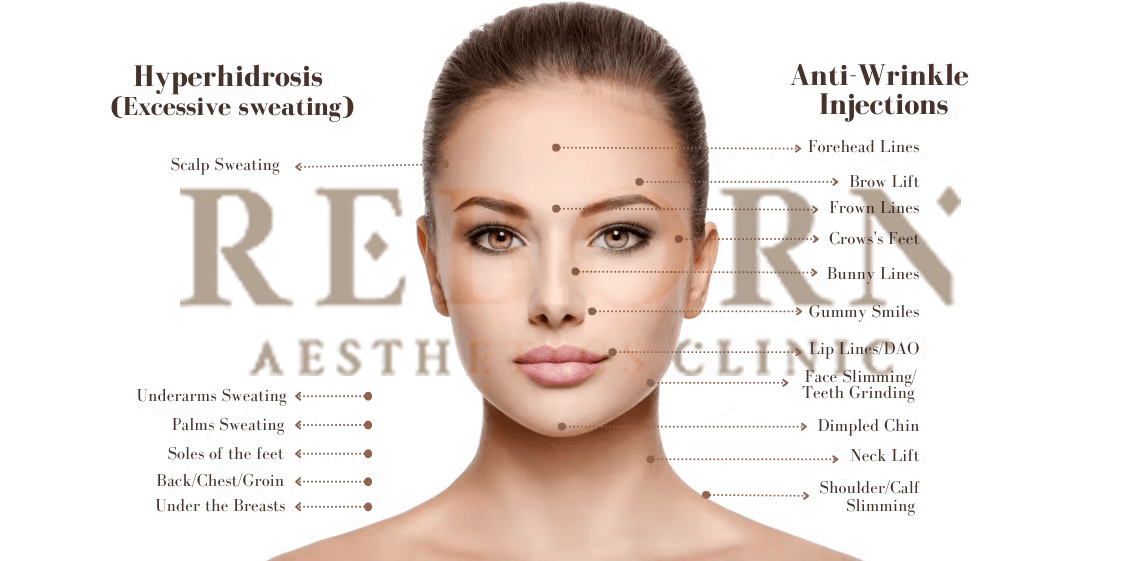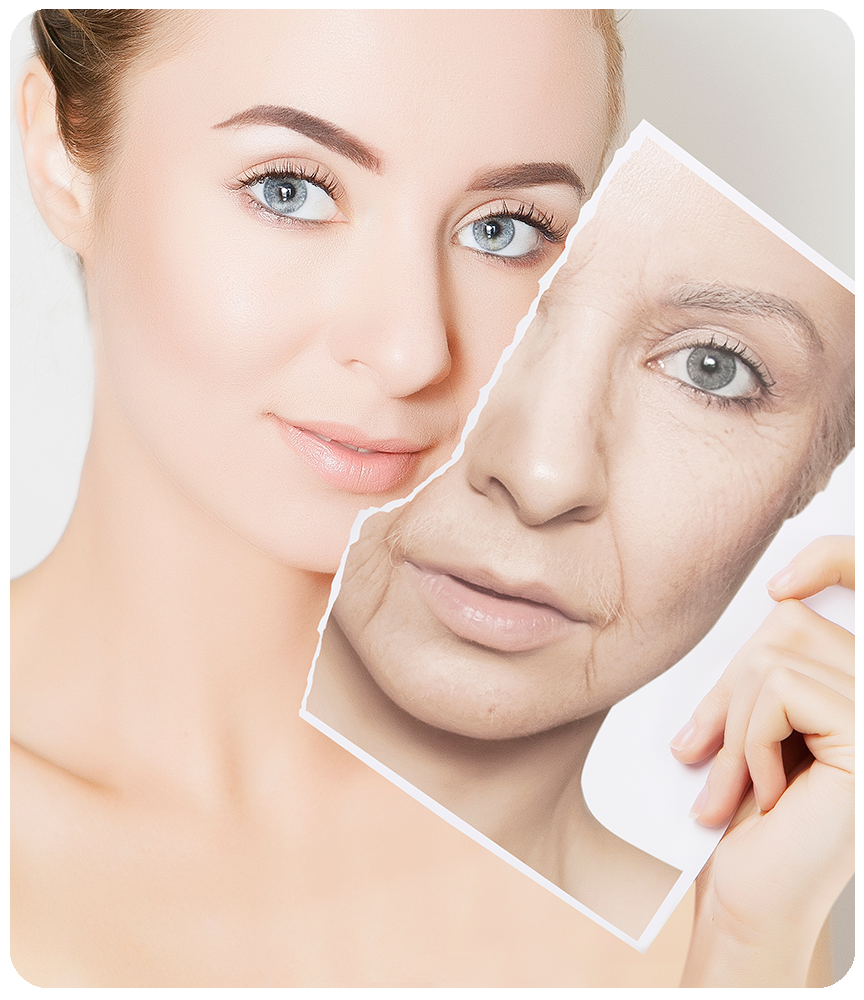How do
BOTULINUM TOXIN WORK?
Botulinum toxin, also known as Botox, is a popular treatment for reducing the appearance of wrinkles and fine lines on the face. However, this powerful neurotoxin has a variety of other medical applications, from treating migraines to reducing excessive sweating. In this article, we'll take a closer look at how botulinum toxin works and explore some of its lesser-known uses.
Anti-Wrinkle Treatment: One of the most common uses of botulinum toxin is to treat wrinkles and fine lines on the face. When injected into the muscles responsible for causing frown lines, forehead lines, and crow's feet, botulinum toxin blocks nerve signals and relaxes the muscles. This, in turn, reduces the appearance of wrinkles and fine lines, giving the face a smoother, more youthful appearance.
Nefertiti Neck Lift: Botulinum toxin can also be used to improve the appearance of the neck and jawline. Known as the Nefertiti Neck Lift, this treatment involves injecting botulinum toxin into the platysma muscles in the neck. This causes the muscles to relax, which in turn lifts and tightens the skin of the neck and jawline.
Masseter Injections / Face Slimming / Teeth Grinding Treatment: Botulinum toxin can also be used to slim the face and reduce the appearance of a square jawline. When injected into the masseter muscles, which are responsible for chewing, botulinum toxin can reduce their size and give the face a more slender, feminine appearance. This treatment can also be used to treat teeth grinding or bruxism, as it relaxes the muscles responsible for clenching and grinding the teeth.
Hyperhidrosis (Sweat Reduction): Botulinum toxin can also be used to reduce excessive sweating, a condition known as hyperhidrosis. When injected into the sweat glands, botulinum toxin blocks the release of a chemical called acetylcholine, which is responsible for activating sweat production. This can help to reduce sweating in the underarms, hands, feet, and other areas of the body.
Trapezius Shoulder Slimming: Botulinum toxin can also be used to reduce the size of the trapezius muscles, which can cause the shoulders to appear broad and bulky. This treatment involves injecting botulinum toxin into the trapezius muscles, which causes them to relax and shrink in size.
Calf Slimming: Botulinum toxin can also be used to reduce the size of the calf muscles, which can be helpful for people who want to achieve a more slender leg appearance. When injected into the gastrocnemius muscles, which are responsible for calf size, botulinum toxin can cause the muscles to relax and shrink in size.
Migraines: Migraines are painful and frustrating, often thought of as extreme headaches that are often accompanied by nausea, vomiting and sensitivity to light and sound. A migraine may last for hours or even days, with the pain being so severe that it can impair normal life and regular function. While the exact cause of migraines is variable and not well understood, muscle relaxants have proven to be effective in preventing migraines before they occur, and are currently used for this purpose worldwide. We use muscle-relaxing injections precisely inserted into specific areas to help our migraine sufferers prevent the onset of this otherwise debilitating condition. (Medicare Benefits Schedule Item 18377)
Haytox: Finally, botulinum toxin can also be used to treat hay fever symptoms. Known as Haytox, this treatment involves spraying botulinum toxin into the nasal passage to block the conduction of nerve signals that trigger the onset of hay fever symptoms. This can help to alleviate symptoms such as sneezing, itching, runny nose, and watery eyes.
Book Your Appointment Today
For appointments and inquiries, please contact us info@rebornaestheticsclinic.com.au or visit our clinic www.rebornaestheticsclinic.com.au. Explore our services and discover the beauty transformation you deserve!

A muscle relaxant treatment can be performed on its own or combined with other procedures for complete facial rejuvenation, such as:
→ Dermal Filler
→ Collagen Stimulator
→ PDO Thread Lift
→ Thermage RF
For more information on cosmetic injectables treatments, please visit https://www.rebornaestheticsclinic.com.au/cosmetic-injectables/
Wrinkle Treatment Areas

RISKS AND COMPLICATIONS
The possible side effects include without limitation:
- Nose and throat irritation
- Headache
- Injection site pain
- Injection site skin reaction
- Upper respiratory tract infection
- Eyelid swelling
- Eyelid drooping
- Sinus inflammation
- Nausea
Tailored Results
Frequently Asked Questions
- Anti-Wrinkle Injection relaxes facial muscles and rebalances muscles and prevents movement that causes wrinkles. Ideal for “expression lines” like forehead lines, frown lines.
- Dermal Filler are hyaluronic gels, and these naturally occur in the body. Fillers add volume by pumping and lifting, commonly used to fill lips, cheeks, under the eyes.

- Do NOT consume alcoholic beverages (alcohol may thin the blood and increase the risk of bruising)
- Do NOT take anti-inflammatory/blood thinning medications, such as Aspirin, Vitamin E, Fish Oil, Ibuprofen, Motrin, Advil, Aleve and other NSAIDS (can increase the risk of bruising and swelling after injections).
- Do NOT receive skin or laser treatment after injections for at least 10 days.
- Do NOT manipulate the treated area for 4 hours following treatment.
- Do NOT lie down for 4 hours after your Botox treatment.
- Do NOT perform activities involving straining, heavy lifting, or vigorous exercise for 24 hours
- Do NOT receive skin or laser treatment after injections for at least 10 days.
- If the desired result is not seen after 2 weeks of your treatment you may need additional units.
- Active infection at the treatment site
- A neurological disorder
- Pregnancy or breastfeeding
- History of anaphylactic shock
- Lidocaine sensitivity
- History of keloid scarring
- Previous use of permanent fillers in the treatment area
- Autoimmune disease
- Porphyria (enzyme disorder)
- Bleeding disorders






















